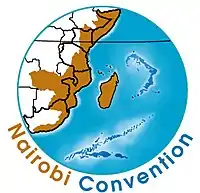Nairobi Convention
The Nairobi Convention[1] is a partnership between governments, civil society and the private sector, working towards a prosperous Western Indian Ocean Region with healthy rivers, coasts and oceans. It pursues this vision by providing a mechanism for regional cooperation, coordination and collaborative actions; it enables the Contracting Parties[2] to harness resources and expertise from a wide range of stakeholders and interest groups; and in this way it helps solve inter-linked problems of the region's coastal and marine environment.
| Convention for the Development, Protection, Management and Development of the Marine and Coastal Environment of the Western Indian Ocean | |
|---|---|
 Official logo of the Convention | |
| Type | Convention |
| Context | Marine conservation |
| Signed | June 21, 1985 |
| Location | Nairobi, Kenya |
| Effective | May 30, 1996 |
| Parties | |
| Languages |
|
Official website | |
History of the Convention
The Nairobi Convention, which was first signed in 1985 and entered into force in 1996, is part of UN Environment's Regional Seas Programme.[3] The programme aims to address the accelerating degradation of the world's oceans and coastal areas through the sustainable management and use of the marine and coastal environment. It does this by engaging countries that share the western Indian Ocean in actions to protect their shared marine environment. The Contracting Parties (Comoros, France, Kenya, Madagascar, Mauritius, Mozambique, Seychelles, Somalia, Tanzania and the Republic of South Africa) to the Convention are part of more than 143 countries that participate in 18 Regional Seas initiatives.[3]
Implementation of projects
The Nairobi Convention Secretariat has successfully implemented various projects within the Western Indian Ocean region through funding from organizations such as GEF[4] and the Governments of Norway and Sweden and through partnerships with other organizations such as Western Indian Ocean Marine Science Association (WIOMSA),[4] Birdlife International,[4] African Union (AU),[4] Indian Ocean Commission (IOC), WWF and IUCN. These include the project Addressing land-based Activities in the Western Indian Ocean (WIO-LaB) project (funded by GEF in 2004-2010) and the African Marine and Coastal Programme (funded by the Swedish government in 2011-2016).
Summary of the Amended Articles of the Convention
The Nairobi Convention Secretariat held the Conference of Plenipotentiaries and the Sixth Conference of Parties (COP6) to the Nairobi Convention at the United Nations Environment Programme (UNEP) Headquarters at Gigiri in Nairobi Kenya, from 29 March to 1 April 2010, which considered and adopted the Amended Nairobi Convention for the Protection, Management and Development of the Marine and Coastal Environment of the Western Indian Ocean.
| Amended Articles |
|---|
| Article 1: Geographical Coverage |
| Article 2: Definitions |
| Article 3: General Provisions |
| Article 4: General Obligations |
| Article 5: Pollution from ships |
| Article 6: Pollution caused by dumping |
| Article 7: Pollution from Land-Based Sources and Activities |
| Article 8: Pollution from Seabed Activities |
| Article 9: Pollution resulting from Transboundary Movement of Hazardous Wastes |
| Article 10: Airborne Pollution |
| Article 11: Biological Diversity |
| Article 12: Co-operation in combating pollution in cases of emergency |
| Article 13: Environmental damage from engineering activities |
| Article 14: Environmental Impact Assessment |
| Article 15: Scientific and technical co-operation |
| Article 16: Liability and Compensation |
| Article 17: Institutional and Financial Arrangements |
| Article 18: Meetings of the Contracting Parties |
| Article 19: Adoption of Protocols |
| Article 20: Amendment of the Convention and its Protocols |
| Article 21: Annexes and amendment of annexes |
| Article 22: Rules of procedure and financial rules |
| Article 23: Special exercise of the right to vote |
| Article 24: Transmission of information |
| Article 25: Settlement of disputes |
| Article 26: Relationship between the Convention and its Protocols |
| Article 27: Compliance and Enforcement |
| Article 28: Sovereignty Claims And Rights |
| Article 29: Signature |
| Article 30: Ratification, Acceptance, Approval And Depositary |
| Article 31: Accession |
| Article 32: Entry into force |
| Article 33: Withdrawal |
| Article 34: Responsibilities of the Depositary |
| Annex on arbitration |
See also
References
- Convention. "Nairobi Convention". www.nairobiconvention.org. Retrieved 2022-02-23.
- Parties. "Contracting Parties | Nairobi Convention". www.nairobiconvention.org. Retrieved 2022-02-23.
- Regional Seas. "Overview | Regional Seas". www.unep.org. Retrieved 2022-02-23.
- Partner. "The Nairobi Convention Brochure | Nairobi Convention". web.unep.org. Retrieved 2017-04-24.
External links
- Convention for the Protection, Management and Development of the Marine and Coastal Environment of the Eastern African Region, Treaty available in ECOLEX-the gateway to environmental law (English)